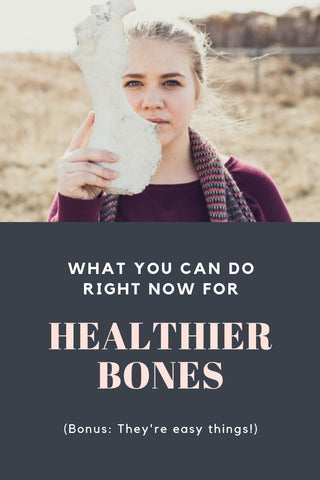What You Can do for Healthier Bones Right Now
It’s time to be g-g-g-good to your bones. Women of every age should prioritize their bone health to ensure strength and stability into their oldest of days. Healthy bones are less susceptible to osteoporosis and injury as we age. So for all you do for healthy skin and general wellness for a long, healthy life, you’ve gotta make sure you’re covering your bones, too.
Mary Hartley, RD, a dietitian with more than 40 years experience who has a particular focus on osteoporosis prevention, said that in the year before menopause starts and in the two years after, it’s “amazing” how much bone women lose; up to 20% in the 5-7 years following menopause.
“If you go into menopause with dense bones, you have some you can afford to lose. But, if you go into menopause with low bone mass, you are totally at risk of losing far too much,” she said. If you can help it, it’s best not to ever lose any.
The task of taking care of your bones shouldn’t feel monumental. In fact, Mary shares some very easy, very accessible things you can start doing...right now!

Consume More Calcium
This is the crux of it all. Women aged 19-50 need about 1,000 milligrams of calcium per day, and after age 50 about 1200 milligrams. The best source is dairy, primarily milk, which serves the calcium in the most bio-available form (i.e. easily absorbed). For those who are lactose intolerant (about 70% of Black women), Mary recommends products like Lactaid.
8 Best Sources of Calcium
- Dairy, namely milk
- Fish with bones, like sardines or salmon
- Calcium-fortified beverages, like orange juice
- Soybeans and tofu (with calcium sulfate)
- Dark greens, like kale and bok choy
- Fruits like figs and oranges
- Almonds
- Bread fortified with calcium
It’s important to note that plant calcium is not as easily absorbed as the animal calcium sources.
Soak Up Enough Vitamin D
You need about 1,000 - 4,000 IU of vitamin D every day, for which the predominant source is the sun. Mary cautions that sunblock interferes with absorption of vitamin D, but that short-term full exposure will give your body the boost of rays that it needs.
Alternatively, vitamin D supplements are a viable source. Lower doses are available over the counter, and higher doses are available via prescription.
Egg yolks and mushrooms also provide some vitamin D, but not at all close to what you need each day. Vitamin D-fortified foods, like milk, are a reasonable source.
Drink Less Booze
Heavy drinking can interfere with the body’s absorption of calcium and other nutrients, creating a perfect storm for lower bone density and higher risk of osteoporosis. For women, Mary reminds that “moderate” drinking is considered one drink per day:
- 12-oz beer
- 5-oz wine
- 1-oz shot
Move Your Bones
Every time you exercise you’re strengthening your bones, and consistent exercise will improve peak bone mass ahead of that critical menopausal cut off.
Galina Denzel, a personal trainer who co-authored Eat Well, Move Well, Live Well, recommends balance exercises to her clients “as a way to increase bone density or functional movement competency.” This is especially true for clients who’ve had a decrease in physical activity, are recovering from an injury or surgery, or already managing an osteoporosis diagnosis.
Additionally, the National Osteoporosis Foundation recommends high-impact, weight-bearing exercise to build strong bones that last. These include dancing, hiking, aerobics, stair climbing, tennis, and jumping rope.
Mary sounded the alarm that most of us have no idea that osteoporosis is a pretty bad public health problem. “Once you ruin your bones, you don’t get them back,” Mary warns. Rally your teenage daughters and work together to invest in your bones now.
Read More
It’s Time to Treat Exercise as Medicine


